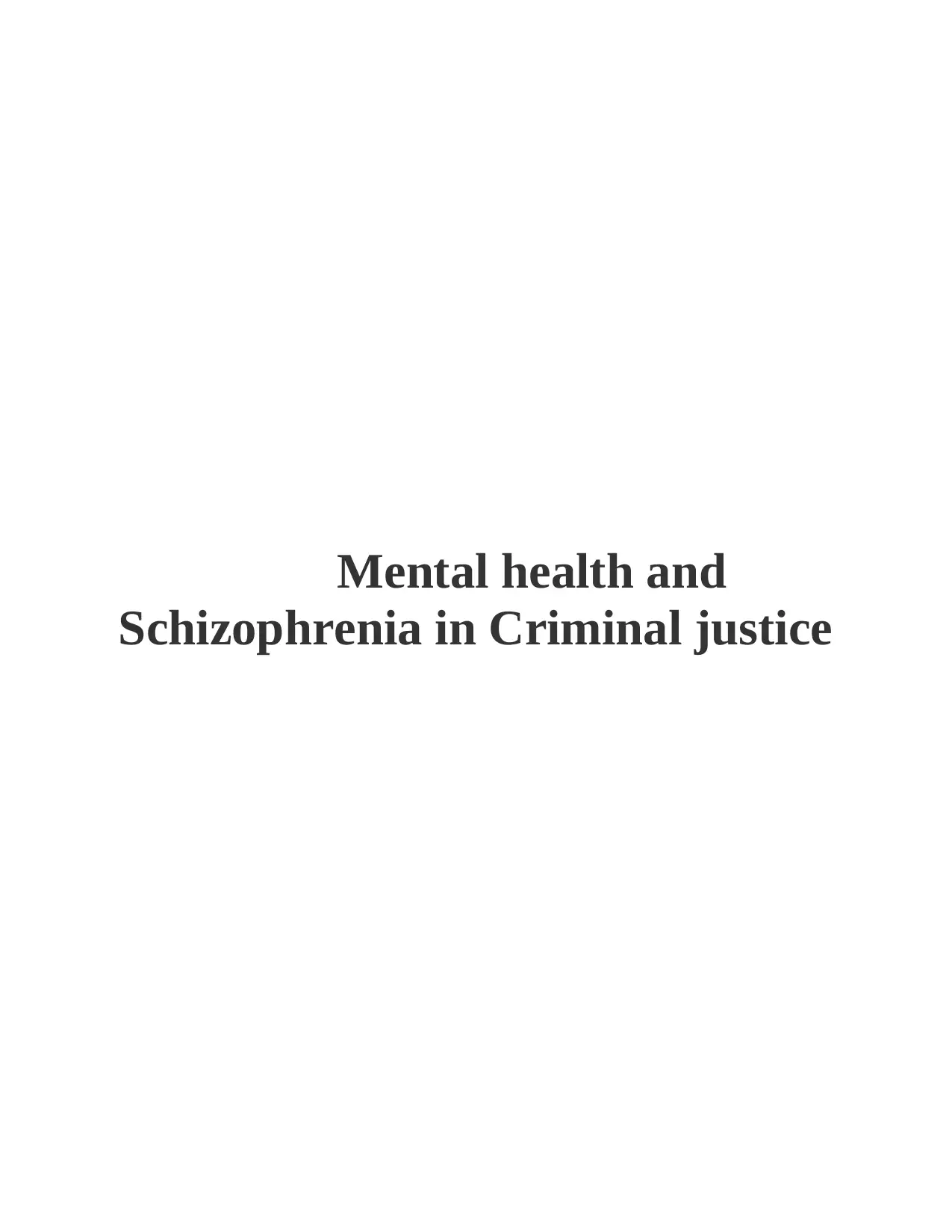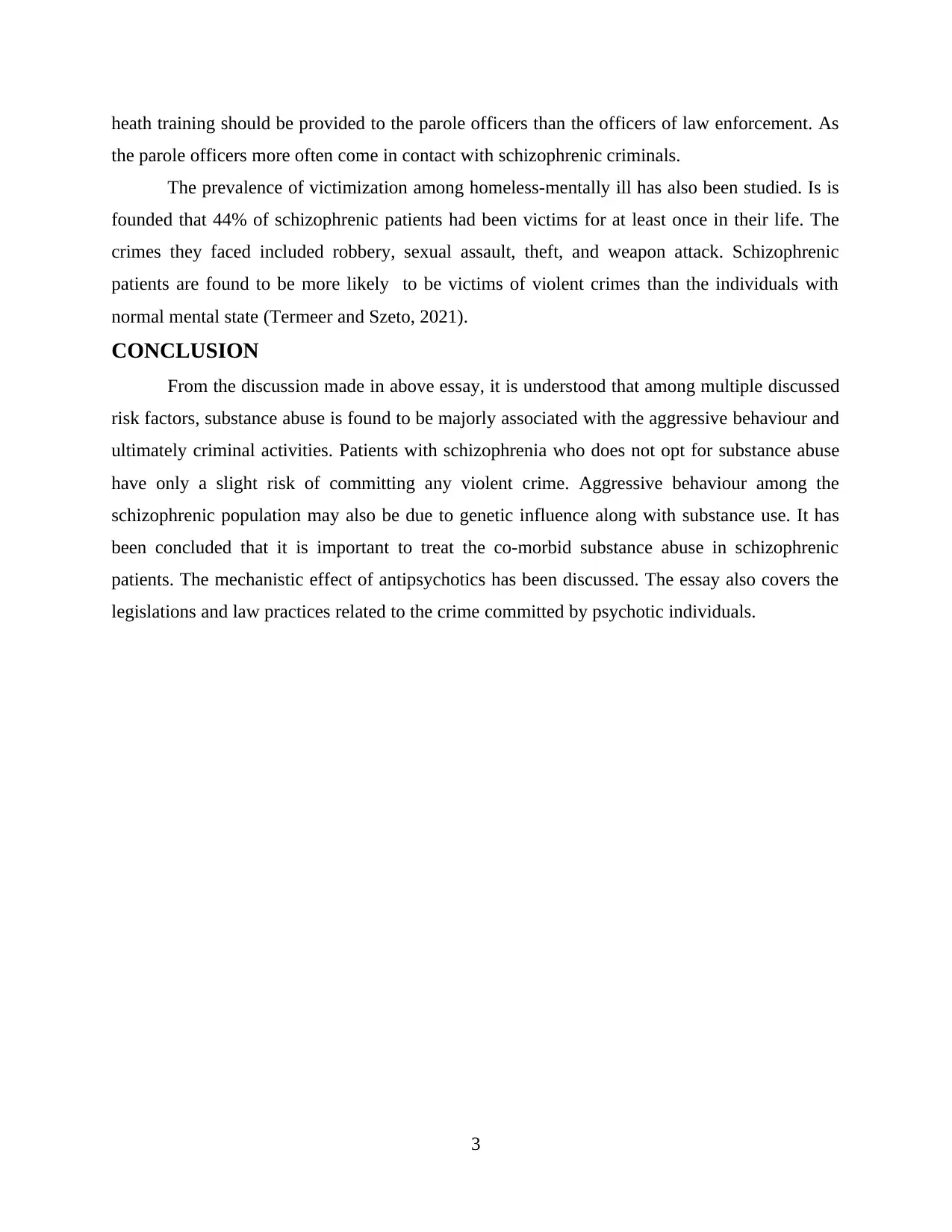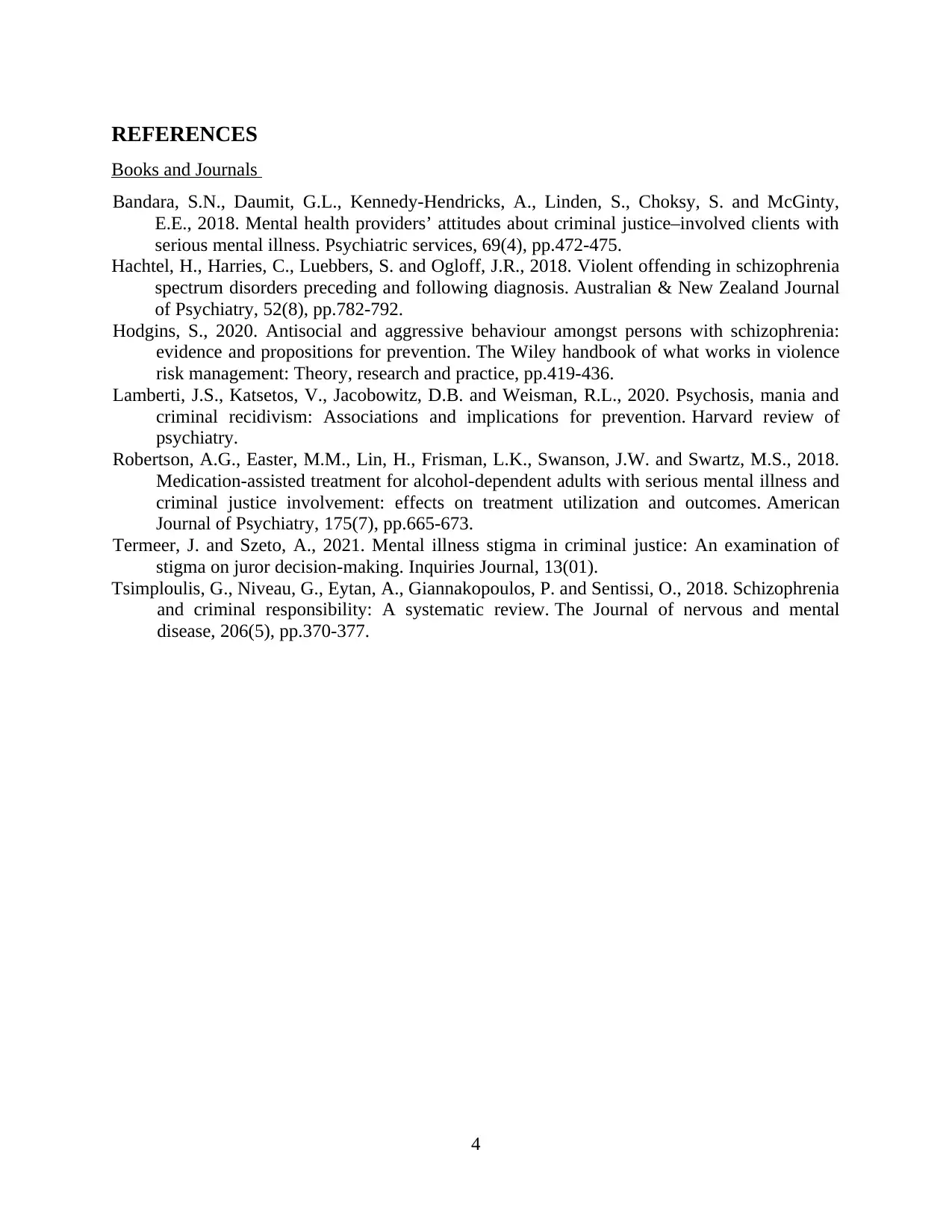Schizophrenia in Criminal Justice: Mental Health and Legal Aspects
VerifiedAdded on 2023/06/08
|7
|1490
|358
Essay
AI Summary
This essay examines the complex relationship between schizophrenia and the criminal justice system, highlighting the increased vulnerability of schizophrenic patients to substance abuse and its correlation with aggressive behavior and criminality. It discusses statistical data on violence among individuals with schizophrenia, emphasizing that while most are not violent, a higher percentage of offenders have the disorder. The essay identifies neurological impairments, social burdens, substance use, and acute psychotic symptoms as key factors contributing to aggressive behavior. It further explores the mechanisms behind substance abuse in schizophrenic patients, including counteracting antipsychotic effects and genetic vulnerabilities. The role of law enforcement, particularly Psychiatric Emergency Response Teams (PERT), and the court's responsibility in determining appropriate actions, such as rehabilitation or imprisonment, are also covered. The essay concludes by emphasizing the importance of addressing co-morbid substance abuse and considering treatment over punishment for mentally ill offenders.

Mental health and
Schizophrenia in Criminal justice
Schizophrenia in Criminal justice
Paraphrase This Document
Need a fresh take? Get an instant paraphrase of this document with our AI Paraphraser

Table of Contents
INTRODUCTION ..........................................................................................................................1
MAIN BODY.................................................................................................................................2
CONCLUSION................................................................................................................................3
REFERENCES ...............................................................................................................................4
INTRODUCTION ..........................................................................................................................1
MAIN BODY.................................................................................................................................2
CONCLUSION................................................................................................................................3
REFERENCES ...............................................................................................................................4

INTRODUCTION
Schizophrenia is a mental illness categorised in class of psychotic disorder. The disorder
mainly characterised by hallucinations, delusions, low mood, and distorted thoughts.
Schizophrenic symptoms are mainly categorised into two types of symptoms that is, negative and
positive. Many researchers are working since a long time to find factors that may are responsible
to develop criminal and violent nature in schizophrenic patient. The fact that come in focus leads
to create an understanding that mostly schizophrenic patients are most vulnerable to substance
abuse due to tendency of self-medication in order to reduce the symptoms of psychosis (Bandara
and et. al., 2018, pp. 473). The substance abuse attributed to increase risk of violence behaviour
and criminality.
MAIN BODY
According to some statistical data, it has been found that 80% people diagnosed with
schizophrenia are not violent, but multiple studies have shown that the person who committed
crime have found at higher rates of schizophrenia. The National Institute of Mental Health shows
that the prevalence of minor violence by schizophrenic patients are 15%. While only 4%
prevalence of serious violence. So these figures forced to believe that the people should not
doubt the connection violent crimes with psychotic order (Tsimploulis and et. al., 2018, pp. 371).
One study has also found that the people with mental illness are generally involved in minor
nuisance activities rather than violent or serious crimes in compared to normal population. A
proper assessment of risk factors has been done by researchers and diagnosed by clinicians to
know the main reason behind aggressive behaviour. The studies have shown that the
neurological impairment, social burdens, substance use, and alcohol abuse are the main
contributing factors for the aggressive behaviour of mentally ill patients (Hachtel and et. al.,
2018, pp. 786). Another factor which observed to increase the risk of violent act among
schizophrenic patient includes acute psychotic symptoms. With acute symptomatology,
researchers estimated that some psychotic offenders are probably driven by delusions. Delusions
are the common psychopathological symptom of psychosis.
There were several hypothesis has made to explain the mechanism behind the nature of
mentally ill patients. Antipsychotic medications act by blocking D2(dopamine) receptors and
interfere with the transmission of neurotransmitters within the whole brain. So patients may
adopt for the abusive drugs to counteract the effect of antipsychotic drugs. Another reason to
1
Schizophrenia is a mental illness categorised in class of psychotic disorder. The disorder
mainly characterised by hallucinations, delusions, low mood, and distorted thoughts.
Schizophrenic symptoms are mainly categorised into two types of symptoms that is, negative and
positive. Many researchers are working since a long time to find factors that may are responsible
to develop criminal and violent nature in schizophrenic patient. The fact that come in focus leads
to create an understanding that mostly schizophrenic patients are most vulnerable to substance
abuse due to tendency of self-medication in order to reduce the symptoms of psychosis (Bandara
and et. al., 2018, pp. 473). The substance abuse attributed to increase risk of violence behaviour
and criminality.
MAIN BODY
According to some statistical data, it has been found that 80% people diagnosed with
schizophrenia are not violent, but multiple studies have shown that the person who committed
crime have found at higher rates of schizophrenia. The National Institute of Mental Health shows
that the prevalence of minor violence by schizophrenic patients are 15%. While only 4%
prevalence of serious violence. So these figures forced to believe that the people should not
doubt the connection violent crimes with psychotic order (Tsimploulis and et. al., 2018, pp. 371).
One study has also found that the people with mental illness are generally involved in minor
nuisance activities rather than violent or serious crimes in compared to normal population. A
proper assessment of risk factors has been done by researchers and diagnosed by clinicians to
know the main reason behind aggressive behaviour. The studies have shown that the
neurological impairment, social burdens, substance use, and alcohol abuse are the main
contributing factors for the aggressive behaviour of mentally ill patients (Hachtel and et. al.,
2018, pp. 786). Another factor which observed to increase the risk of violent act among
schizophrenic patient includes acute psychotic symptoms. With acute symptomatology,
researchers estimated that some psychotic offenders are probably driven by delusions. Delusions
are the common psychopathological symptom of psychosis.
There were several hypothesis has made to explain the mechanism behind the nature of
mentally ill patients. Antipsychotic medications act by blocking D2(dopamine) receptors and
interfere with the transmission of neurotransmitters within the whole brain. So patients may
adopt for the abusive drugs to counteract the effect of antipsychotic drugs. Another reason to
1
⊘ This is a preview!⊘
Do you want full access?
Subscribe today to unlock all pages.

Trusted by 1+ million students worldwide

adopt for the abuse drug substances by mentally ill patients is directly related with the reduction
of Dopaminergic receptors. Genetic vulnerability to the co-morbidity is determined by the
overlapping of genes between addiction of drugs and schizophrenia. So the correlation between
the aggressive behaviour and schizophrenia is due to drug substance is well defined. High
impulsive and aggressive behaviour of schizophrenic population leads to face many problems.
This population is more likely to develop the behaviour of recidivism and violent actions during
the period of detention which signifies the judicial problems with this population (Hodgins,
2020, pp. 426).
So with the limited but obvious connections of schizophrenic population with crime,
logically explains the frequency of schizophrenia comes in contact with the legal system of
criminal justice. Law enforcement is generally common to come in contact with schizophrenics.
The law enforcement activities either be related to the one who commit the crime or the victim.
Special criminal law enforcement team is recruited in law departments to handle the cases linked
to the schizophrenic conditions named Psychiatric Emergency Response Team (PERT). These
types of forces are specially trained to understand and handle the situation adequately. PERT's
dedicated officers maintains partnership with experienced, well trained and licensed health
clinicians. They work together to solve the cases and assess the situation in order to understand
the mental health of the patient and then move forward to the next step accordingly. When the
case has been proceed and reaches to the court (Lamberti and et. al., 2020). It is the court;s
responsibility to take adequate action for the criminal suffering from mental illness.
The court have to determine what will be the appropriate course of action for the criminal
whether it is to send the criminal in rehabilitation centre and provided with a proper treatment or
the suitable action is to sentence the criminal with imprisonment. It has been also found by some
researchers that majority of time the undiagnosed or untreated schizophrenics are ended up with
imprisonment for their minor criminal offenses. So to avoid such practices and to handle this
challenging population in a better manner, the court must consider and prioritize treatment for
the mentally ill criminals rather than punishment or incarcerated them in the jail. Statistically, it
has ben found that approximately 10% of jail population, and 18% population of state prison,
16% population of federal prison have the imprisoned criminals suffering from psychotic illness.
It is obvious that prison life is too hard to bear but for schizophrenic patients the conditions
might get even worse (Robertson and et. al., 2018, pp. 668). The importance of proper mental
2
of Dopaminergic receptors. Genetic vulnerability to the co-morbidity is determined by the
overlapping of genes between addiction of drugs and schizophrenia. So the correlation between
the aggressive behaviour and schizophrenia is due to drug substance is well defined. High
impulsive and aggressive behaviour of schizophrenic population leads to face many problems.
This population is more likely to develop the behaviour of recidivism and violent actions during
the period of detention which signifies the judicial problems with this population (Hodgins,
2020, pp. 426).
So with the limited but obvious connections of schizophrenic population with crime,
logically explains the frequency of schizophrenia comes in contact with the legal system of
criminal justice. Law enforcement is generally common to come in contact with schizophrenics.
The law enforcement activities either be related to the one who commit the crime or the victim.
Special criminal law enforcement team is recruited in law departments to handle the cases linked
to the schizophrenic conditions named Psychiatric Emergency Response Team (PERT). These
types of forces are specially trained to understand and handle the situation adequately. PERT's
dedicated officers maintains partnership with experienced, well trained and licensed health
clinicians. They work together to solve the cases and assess the situation in order to understand
the mental health of the patient and then move forward to the next step accordingly. When the
case has been proceed and reaches to the court (Lamberti and et. al., 2020). It is the court;s
responsibility to take adequate action for the criminal suffering from mental illness.
The court have to determine what will be the appropriate course of action for the criminal
whether it is to send the criminal in rehabilitation centre and provided with a proper treatment or
the suitable action is to sentence the criminal with imprisonment. It has been also found by some
researchers that majority of time the undiagnosed or untreated schizophrenics are ended up with
imprisonment for their minor criminal offenses. So to avoid such practices and to handle this
challenging population in a better manner, the court must consider and prioritize treatment for
the mentally ill criminals rather than punishment or incarcerated them in the jail. Statistically, it
has ben found that approximately 10% of jail population, and 18% population of state prison,
16% population of federal prison have the imprisoned criminals suffering from psychotic illness.
It is obvious that prison life is too hard to bear but for schizophrenic patients the conditions
might get even worse (Robertson and et. al., 2018, pp. 668). The importance of proper mental
2
Paraphrase This Document
Need a fresh take? Get an instant paraphrase of this document with our AI Paraphraser

heath training should be provided to the parole officers than the officers of law enforcement. As
the parole officers more often come in contact with schizophrenic criminals.
The prevalence of victimization among homeless-mentally ill has also been studied. Is is
founded that 44% of schizophrenic patients had been victims for at least once in their life. The
crimes they faced included robbery, sexual assault, theft, and weapon attack. Schizophrenic
patients are found to be more likely to be victims of violent crimes than the individuals with
normal mental state (Termeer and Szeto, 2021).
CONCLUSION
From the discussion made in above essay, it is understood that among multiple discussed
risk factors, substance abuse is found to be majorly associated with the aggressive behaviour and
ultimately criminal activities. Patients with schizophrenia who does not opt for substance abuse
have only a slight risk of committing any violent crime. Aggressive behaviour among the
schizophrenic population may also be due to genetic influence along with substance use. It has
been concluded that it is important to treat the co-morbid substance abuse in schizophrenic
patients. The mechanistic effect of antipsychotics has been discussed. The essay also covers the
legislations and law practices related to the crime committed by psychotic individuals.
3
the parole officers more often come in contact with schizophrenic criminals.
The prevalence of victimization among homeless-mentally ill has also been studied. Is is
founded that 44% of schizophrenic patients had been victims for at least once in their life. The
crimes they faced included robbery, sexual assault, theft, and weapon attack. Schizophrenic
patients are found to be more likely to be victims of violent crimes than the individuals with
normal mental state (Termeer and Szeto, 2021).
CONCLUSION
From the discussion made in above essay, it is understood that among multiple discussed
risk factors, substance abuse is found to be majorly associated with the aggressive behaviour and
ultimately criminal activities. Patients with schizophrenia who does not opt for substance abuse
have only a slight risk of committing any violent crime. Aggressive behaviour among the
schizophrenic population may also be due to genetic influence along with substance use. It has
been concluded that it is important to treat the co-morbid substance abuse in schizophrenic
patients. The mechanistic effect of antipsychotics has been discussed. The essay also covers the
legislations and law practices related to the crime committed by psychotic individuals.
3

REFERENCES
Books and Journals
Bandara, S.N., Daumit, G.L., Kennedy-Hendricks, A., Linden, S., Choksy, S. and McGinty,
E.E., 2018. Mental health providers’ attitudes about criminal justice–involved clients with
serious mental illness. Psychiatric services, 69(4), pp.472-475.
Hachtel, H., Harries, C., Luebbers, S. and Ogloff, J.R., 2018. Violent offending in schizophrenia
spectrum disorders preceding and following diagnosis. Australian & New Zealand Journal
of Psychiatry, 52(8), pp.782-792.
Hodgins, S., 2020. Antisocial and aggressive behaviour amongst persons with schizophrenia:
evidence and propositions for prevention. The Wiley handbook of what works in violence
risk management: Theory, research and practice, pp.419-436.
Lamberti, J.S., Katsetos, V., Jacobowitz, D.B. and Weisman, R.L., 2020. Psychosis, mania and
criminal recidivism: Associations and implications for prevention. Harvard review of
psychiatry.
Robertson, A.G., Easter, M.M., Lin, H., Frisman, L.K., Swanson, J.W. and Swartz, M.S., 2018.
Medication-assisted treatment for alcohol-dependent adults with serious mental illness and
criminal justice involvement: effects on treatment utilization and outcomes. American
Journal of Psychiatry, 175(7), pp.665-673.
Termeer, J. and Szeto, A., 2021. Mental illness stigma in criminal justice: An examination of
stigma on juror decision-making. Inquiries Journal, 13(01).
Tsimploulis, G., Niveau, G., Eytan, A., Giannakopoulos, P. and Sentissi, O., 2018. Schizophrenia
and criminal responsibility: A systematic review. The Journal of nervous and mental
disease, 206(5), pp.370-377.
4
Books and Journals
Bandara, S.N., Daumit, G.L., Kennedy-Hendricks, A., Linden, S., Choksy, S. and McGinty,
E.E., 2018. Mental health providers’ attitudes about criminal justice–involved clients with
serious mental illness. Psychiatric services, 69(4), pp.472-475.
Hachtel, H., Harries, C., Luebbers, S. and Ogloff, J.R., 2018. Violent offending in schizophrenia
spectrum disorders preceding and following diagnosis. Australian & New Zealand Journal
of Psychiatry, 52(8), pp.782-792.
Hodgins, S., 2020. Antisocial and aggressive behaviour amongst persons with schizophrenia:
evidence and propositions for prevention. The Wiley handbook of what works in violence
risk management: Theory, research and practice, pp.419-436.
Lamberti, J.S., Katsetos, V., Jacobowitz, D.B. and Weisman, R.L., 2020. Psychosis, mania and
criminal recidivism: Associations and implications for prevention. Harvard review of
psychiatry.
Robertson, A.G., Easter, M.M., Lin, H., Frisman, L.K., Swanson, J.W. and Swartz, M.S., 2018.
Medication-assisted treatment for alcohol-dependent adults with serious mental illness and
criminal justice involvement: effects on treatment utilization and outcomes. American
Journal of Psychiatry, 175(7), pp.665-673.
Termeer, J. and Szeto, A., 2021. Mental illness stigma in criminal justice: An examination of
stigma on juror decision-making. Inquiries Journal, 13(01).
Tsimploulis, G., Niveau, G., Eytan, A., Giannakopoulos, P. and Sentissi, O., 2018. Schizophrenia
and criminal responsibility: A systematic review. The Journal of nervous and mental
disease, 206(5), pp.370-377.
4
⊘ This is a preview!⊘
Do you want full access?
Subscribe today to unlock all pages.

Trusted by 1+ million students worldwide

5
1 out of 7
Related Documents
Your All-in-One AI-Powered Toolkit for Academic Success.
+13062052269
info@desklib.com
Available 24*7 on WhatsApp / Email
![[object Object]](/_next/static/media/star-bottom.7253800d.svg)
Unlock your academic potential
Copyright © 2020–2026 A2Z Services. All Rights Reserved. Developed and managed by ZUCOL.





